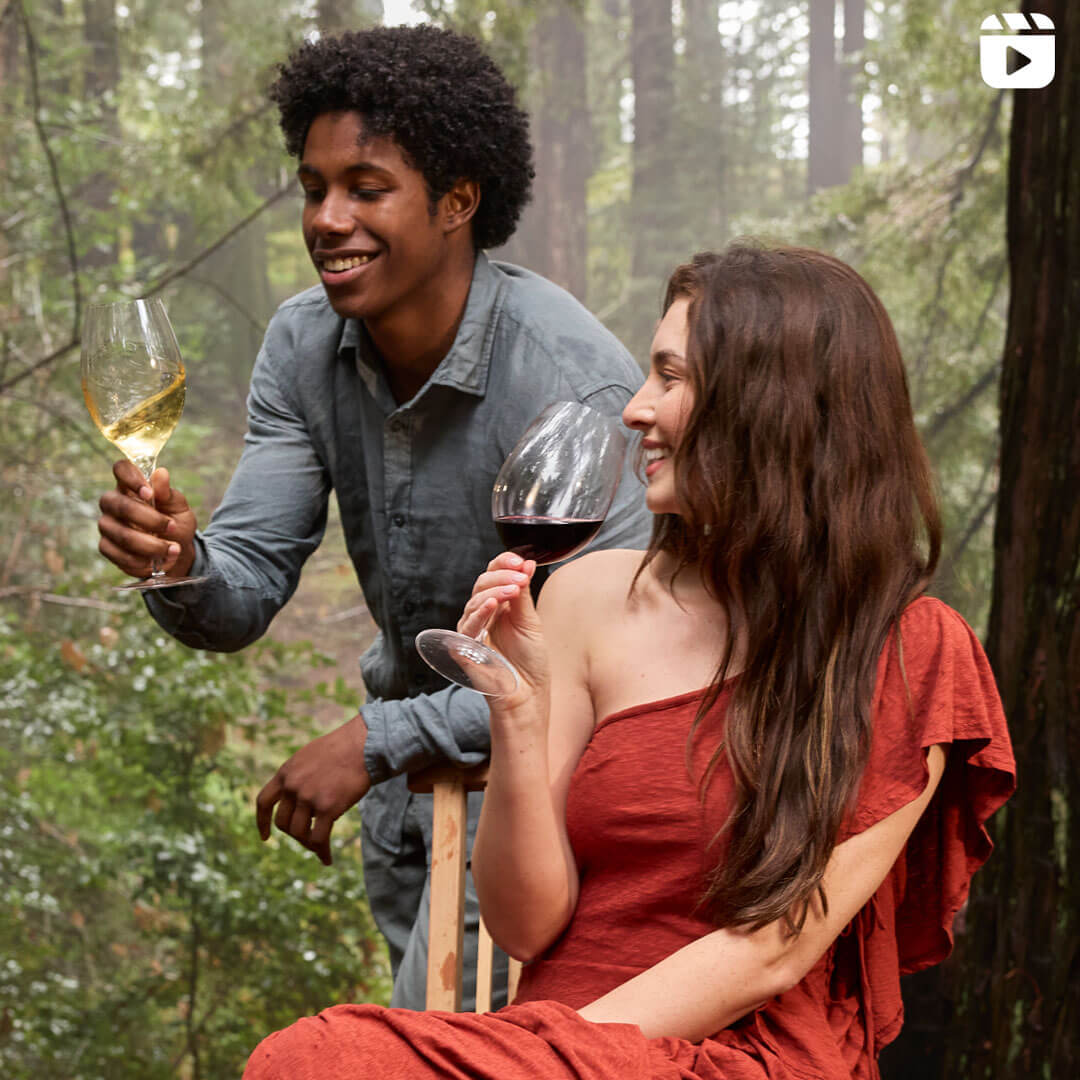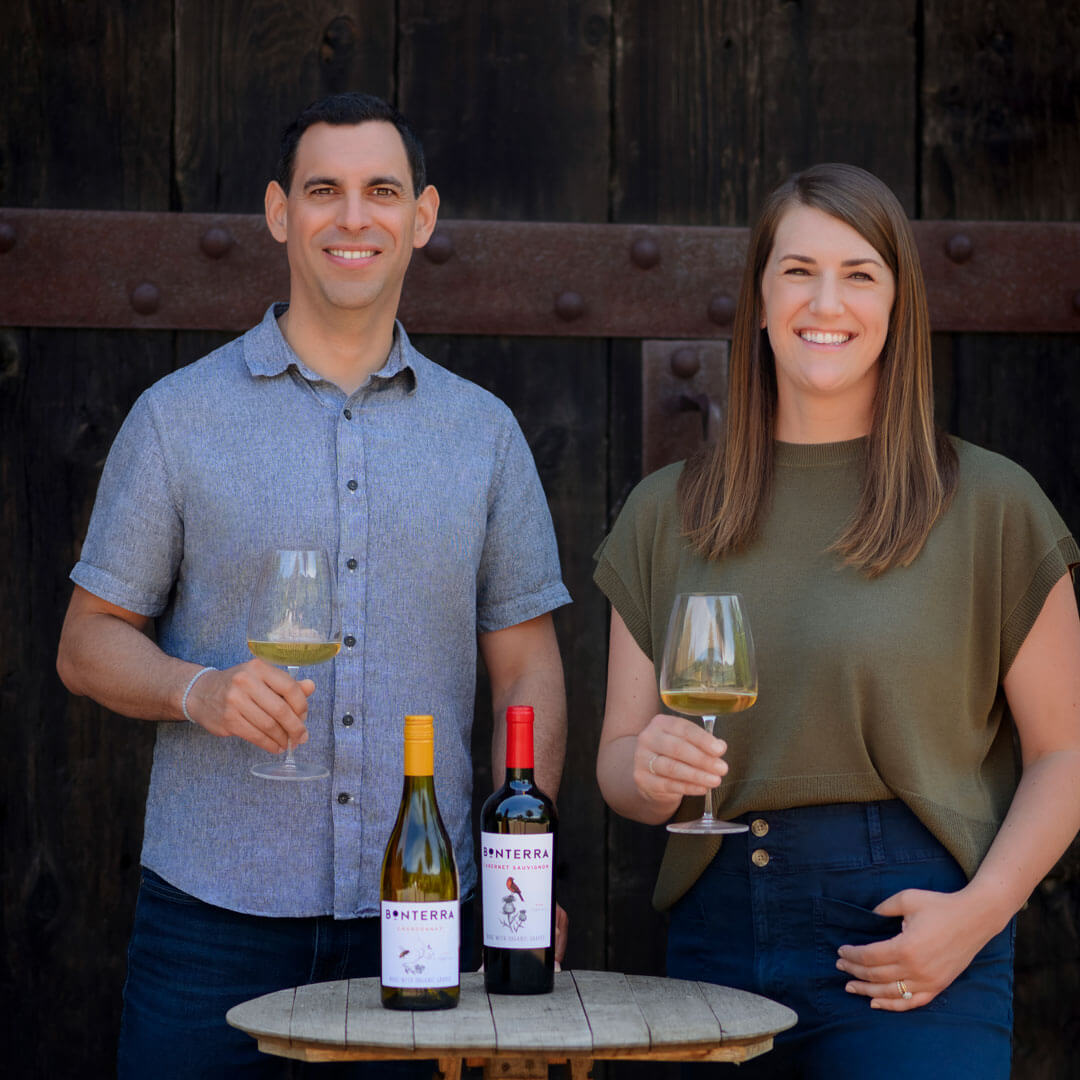Do you want to level up your wine tasting experience and describe wines like a pro? Whether or not you dream of starring in the next SOMM film, understanding the basics of professional wine tasting can dramatically enhance your enjoyment of wine.
If you’re ready to get serious about refining your tasting skills, Bonterra’s selection of wines are an ideal starting point – classic, approachable, and sustainably produced from organic grapes.
The Basics of Wine Tasting
The five key steps of professional wine tasting have a convenient shorthand to help us remember them – “the Five S’s.”
- See: We taste with our eyes first!
- Swirl: This step releases the distinct aromas of a wine into the air, and makes them more accessible to us.
- Sniff: We put our nose to work, taking in all the aromatic clues we just released by swirling.
- Sip: At long last, we taste! Our palates are primed to notice the wines flavors and textures it offers.
- Savor: Reflecting on what we’ve just swallowed (or spit). What flavors and impressions remain?
To optimize the 5 S’s, we recommend tasting in a well-lit environment – so you can see the wine clearly – using proper glassware (a rounded shape with a thin lip) that you can swirl. Also make sure that the wine being tasted is the right temperature: 45-52°F for white and rosé wines, and 55-65 °F for reds. Temperature has a big impact on how we perceive and appreciate the acidity, texture, and aromas of wine.
Step-by-Step Guide to Tasting Wine Like a Sommelier
Let’s dig into the 5 S’s more deeply now, and discuss what we’re doing and why at each step.
Step 1: Visual Inspection (See).
A wine can tell us a surprising amount about itself with just a visual inspection. Hold the wine glass at a 45-degree angle with something white behind it (a sheet of paper on the table works just fine) so you have a clear view.
What color is it? Does it have bubbles or effervescence? Is the wine opaque (not letting light through) or translucent? These details can give us clues about what grape varietals are involved, since some grape varieties produce darker, richer colors than others.
A wine’s color also typically hints at its age. Young white wines are usually pale yellow or light golden with brilliant highlights, but they lose those dazzling reflections and develop darker golden colors with time. Young red wines are typically bright red or purple with a magenta halo around the edges (called “the rim”); with age, the bright intensity of color tends to diminish, and the rim becomes more of an orange or brick color.
Step 2: Swirling the Wine (Swirl).
This second step is more than just an impressive party trick. Swirling wine in a glass does two important things: it causes the wine to interact more intensely with oxygen, which “opens up” the wine to greater aromatic potential. And, the physical motion pushes the molecules that bring us scents and flavors out of the wine and into the air, where we can more easily access them with our noses. You don’t want the wine to come all the way up to the edges of the glass, but you do want to move it around like a controlled whirlpool.
If you’re new to swirling, it’s helpful to leave the glass sitting on the table, and just move the base of the glass in small circles on the surface. Once you’ve mastered swirling on the table, try picking up the glass (from the stem) and swirling it the same way in the air.
Step 3: Smelling the Wine (Sniff).
Did you know that nearly all of the “flavors” we experience are actually aromas? Our sense of smell is what tells us the difference between cherry and strawberry candy – not our taste buds. This is why smelling wine is so important, and comes before we actually taste the wine.
When we sniff a wine like Bonterra Cabernet Sauvignon, we notice distinct aromas that remind us of black cherries and dried herbs. With Bonterra Sauvignon Blanc, we think about grapefruit and tropical fruits like kiwi. The fruity, floral, mineral or earthy aromas that come from the grape itself are called the “primary aromas.” “Secondary aromas” are scents that are created by the winemaking process, such as baking spice and vanilla (both from oak barrels). “Tertiary aromas” like nuttiness or leather are scents that come from aging in the bottle.
Don’t worry about distinguishing primary aromas from secondary or tertiary aromas when you’re just starting out. The most important thing is picking out and describing the scents that you recognize in the wine.
Step 4: Tasting the Wine (Sip).
Sipping wine is different from sipping a glass of water or a beer. You want to take a sip that’s large enough to coat your entire mouth, but small enough that you can comfortably swish it around. The goal here is to assess the wine’s flavors, body, texture, acidity and structure.
Hold the wine in the front of your mouth, purse your lips and breathe in a little air as if you’re slurping ramen noodles. This air helps the scent molecules in the wine reach the scent receptors in your palate. Pay attention to any aromas and different flavors you notice – they often give us clues about the grape variety we are tasting. With Chardonnay, we might notice buttery apple aromas with a hint of vanilla. With Zinfandel, we’re likely to find blueberries and peppery spice.
Now swish the wine around your mouth so you can experience the texture and body of the wine, and assess how acidic or tannic it is. This step will underscore the difference between a lighter-bodied red with soft tannins (like Bonterra Pinot Noir) and a full-bodied red with bolder tannins (like Bonterra’s Red Blend). Sensing the acidity can also help us distinguish between a zesty Sauvignon Blanc and a more neutral Pinot Grigio.
When you’re done swishing, it’s time to either swallow your mouthful of wine or spit it out. Spitting helps you keep a clear head if you’re tasting many wines in a row – or really, doing anything else that requires careful attention. Swallowing the wine lets you experience the wine’s texture all the way down, which sometimes brings additional insights and enjoyment for a wine lover.
Step 5: Savoring and Describing the Wine (Savor).
Finally, we sit back and savor our wine tasting experience. This is the time to reflect on the wine’s overall balance, and assess its finish.
Balance is often subjective, as some people enjoy very tannic or acidic wines while others do not. Consider how balanced the wine felt to you, thinking about the wine’s texture, freshness, and fruitiness.
The “finish” is the experience a wine leaves us with once it has left our mouth. The best wines have complex tasting notes and aromas that linger a long time afterward – sometimes several minutes. Ideally, a finish is pleasant and harmonizes with the other aspects of the wine.
Advanced Tasting Techniques
Once you’ve mastered the professional tasting technique, you’re ready to deepen your expertise and your enjoyment! Here are three techniques – inspired by sommelier training – to help you get more out of every bottle you open.
Keeping a Wine Journal: For mere mortals like us, taking notes on tasting experiences is the best way to understand personal preferences. No one can remember what they think of every wine they open, unless they make some record of it! Taking notes also makes it easier to learn about different styles of wines, and different winegrowing regions. While traditionally somms would use a physical journal, smartphone apps now offer convenient ways to keep track of your tasting adventures, wherever they happen to be.
Blind Tasting Practice: Tasting wines without knowing what they are is a standard way for sommeliers to refine their palates and knowledge of wine. It forces you to focus intently on the sensory input in front of you, and gather as many details as possible – then compare your data points to what you know about the different wines of the world. Can you guess the variety? The country of origin? The approximate age? Blind tasting is both fun and humbling, and a great way to hone your tasting skills and knowledge.
Identifying Wine Flaws: Being able to distinguish a flawed wine from one with unusual aromatic notes is incredibly empowering. Some wine flaws are unique to a particular bottle, while others can be present in a winery’s entire production. It’s worth learning the difference between them so you can determine if you’d like to try another bottle!
If you smell wet cardboard in a wine, and its fruity aromas are flat and dull, the wine likely has “cork taint” – a condition caused by the presence of 2,4,6-trichloroanisole (a.k.a. TCA). Because it is most often caused by the cork, cork taint typically only affects particular bottles, so you should return any wine you think has TCA to the place you bought it, and ask for a fresh bottle.
The most common wine fault is probably oxidation – the excess exposure to oxygen, which can happen during winemaking, or after bottling with an imperfect seal. Oxidation turns wines a browner color and flattens out their fruit aromas into a dusty beef stock flavor. This can affect bottles that have been improperly stored, so we would recommend trying another bottle that has been stored somewhere else.
If your wine smells like a struck match, boiled cabbage, or rotten eggs, it has a higher concentration of sulfur compounds than it should. This is probably a production-wide problem, and you’re unlikely to get a different result with a different bottle. (In addition to using two-thirds less sulfur than conventional producers, Bonterra has strict quality standards that ensure no flawed wines leave our organic winery!)
Now that you know how to taste wine like a sommelier, we hope you’ll put that knowledge into action! With eight different wines, Bonterra’s Intro Set is the perfect, one-click order to hone your tasting skills. If you want to go deep on one grape to see how different sourcing and winemaking decisions affect our experience, the Cabernet Sauvignon Bundle or Chardonnay Bundle would be ideal.
Additionally, explore our high scoring wine sampler, featuring 6 bottles made with regenerative organic grapes from a single Bonterra estate vineyard in Mendocino County—recognized as Wine Enthusiast‘s Wine Region of the Year in 2024. These extremely high scoring wines with incredible flavor showcase the exceptional quality and unique character of our sustainably farmed vineyards.
Learn More About Wine Tasting with Bonterra
Mastering the art of wine tasting can greatly enhance your appreciation for the unique flavors and complexities in every bottle. Bonterra’s commitment to sustainability ensures that each Bonterra wine, whether you’re enjoying a red wine or a white wine, offers an exceptional tasting experience. Consider exploring our red wine sampler or white wine sampler, which are perfect introductory bundles for anyone looking to expand their wine selection. These thoughtfully curated sets allow you to delve into and enjoy the distinctive nuances of each varietal.
With our curated selections, you can explore the world of wine with confidence, honing your skills as a wine enthusiast. Discover the perfect wines for your journey into the world of tasting like a sommelier. From shopping for wine online to joining our wine club, we have something for every wine enthusiast.
No matter what bottle you open next, we hope your wine tasting journey becomes a lifelong adventure. Cheers!




